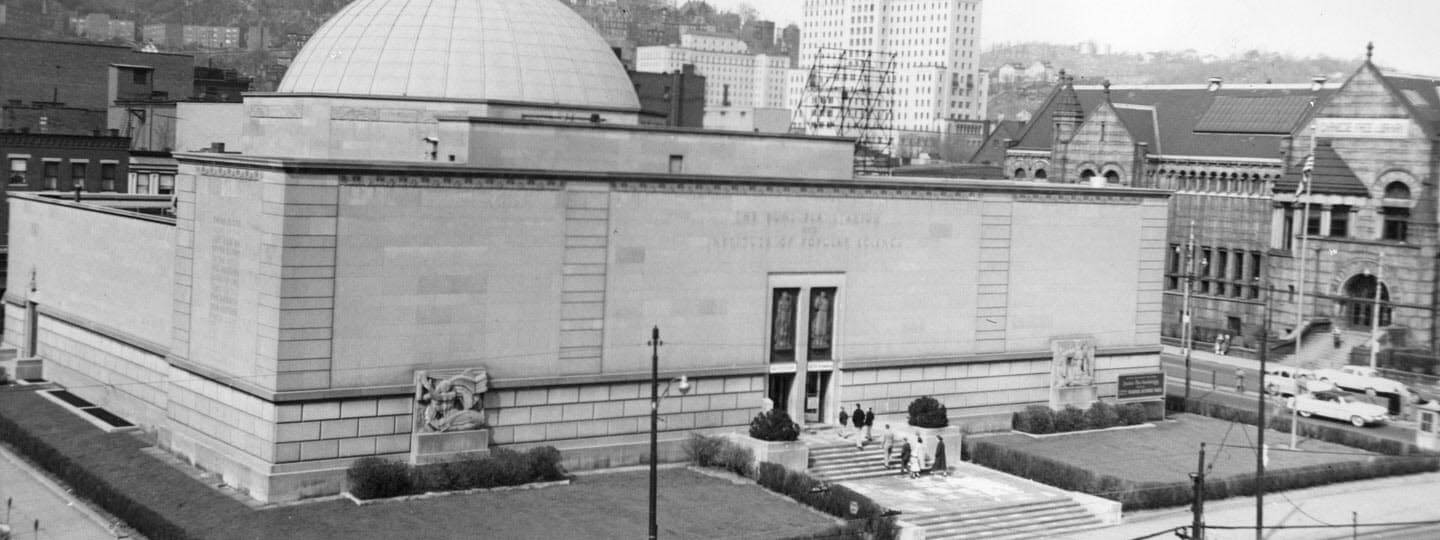
Buhl Planetarium History
The Buhl Planetarium and Institute of Popular Science first opened its doors in October 1939 on Pittsburgh’s North Side. It was the fifth major planetarium in the United States—joining those in Chicago, New York, Los Angeles, and Philadelphia. Built for $1,070,000 by the Buhl Foundation—which was established in the will of North Side businessman Henry Buhl—the planetarium featured a 492-seat “Theater of the Stars” with a 65-foot diameter dome. In 1940, some 200,000 people visited the planetarium to gaze at images of the night skies produced by the Zeiss Model II electro-mechanical projector, which rose out of the floor like a phantom menace. On the planetarium’s roof, a siderostat telescope allowed visitors to follow stars and planets across the night sky. It was the first such telescope designed for public use rather than astronomical research. Hundred of thousands of Pittsburghers remember trips to Buhl Planetarium in the 1940s through the 1980s.
In 1982, the Buhl Planetarium became the Buhl Science Center and began plans to relocate to a prime parcel of land on the Ohio River just below the current Heinz Field. In 1987, the Buhl Science Center merged with Carnegie Museums of Pittsburgh, and five years later, in October of 1991, a new planetarium—The Henry Buhl, Jr. Planetarium & Observatory—opened in the newly established Carnegie Science Center.
The “new Buhl,” underwritten by the Buhl Foundation, has served as a state-of-the-art facility and a model for planetariums around the world. With 150 seats and a 50-foot dome, it has long been one of the most technically sophisticated planetariums of the approximately 3000 worldwide in existence—and one of only a few dozen with interactive capabilities. Sophisticated “flight controllers”—an interactive system mounted in every armrest of the theater—allow audiences to focus on a particular area of the screen and manipulate the direction a program will take in real time—panning right or left and speeding up or slowing down the show. A majority vote determines what the audience will see.
Carnegie Science Center has established itself internationally as a leading creator of quality planetarium programs with innovative content. The Science Center’s planetarium staff have distributed more than 400 shows that are seen throughout the United States and on four other continents. These shows have been translated into 18 languages. Buhl Planetarium productions have become so highly regarded, they’ve attracted the talents of futurist and science-fiction author Sir Arthur C. Clarke, actor Leonard Nimoy (who narrated the shows New Cosmos and The Search for Life in the Universe, respectively), NASA, the Space Telescope Science Institute (STScI, a branch of NASA), The Center for Light Microscope Imaging and Biotechnology, Pittsburgh Tissue Engineering Initiative (PTEI), and Family Communications (producer of Mister Rogers’ Neighborhood).
In 1995, Buhl Planetarium took a giant leap forward by creating a show not about distant galaxies and fiery stars, but about the human body. Journey into the Living Cell was developed in collaboration with Carnegie Mellon University and was followed by Gray Matters: The Brain Movie in 2000. In 2003, Buhl Planetarium debuted Tissue Engineering for Life, sponsored by the National Institutes of Health and GlaxoSmithKline Consumer Healthcare, which includes segments on stem cell research, the heart and the spine.
In September 2006, Carnegie Science Center installed a full-dome digital projection system purchased with a $1 million gift from the Buhl Foundation. The visual impact and programming flexibility of this system vastly expands the nature and breadth of subject matter showcased in the planetarium. Although the new system will be used most extensively for astronomy programs, it also has application to other scientific fields, particularly the biological sciences, chemistry and engineering/architecture.

